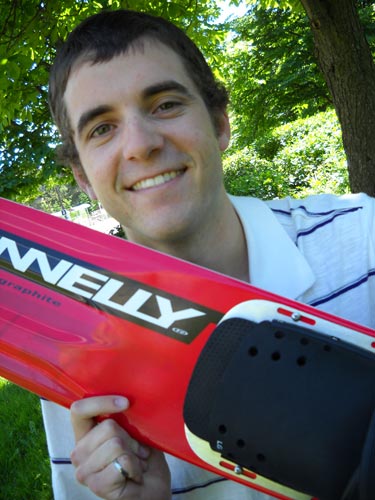
Wanted: seasoned water skiers willing to stand up for science. That might be the recruitment line for a Guelph engineering student designing a study in cottage country this summer that will bring together biomechanics, human health and recreation.
“You can tie in engineering with your personal passion,” says Jordan Bray-Miners, a certified water-skiing instructor who did just that when he began his master’s studies in biological engineering last fall.
For two days next month, his subjects will carve up the water at a private lake in Ontario’s Kawarthas. Fun in the sun? Yes, but it’s work, too.
By collecting a boatload of data, he hopes to help lure back average skiers like his U of G supervisor to a healthful form of exercise with less of the attendant strain on aging arms and legs.
For biomechanics researchers, says Bray-Miners, this is mostly open water. Few researchers ─ including R&D departments in ski manufacturing companies ─ have published results of water-ski studies. “It’s cool being one of the first people to put numbers to things that were strictly qualitative before.”
Among the few researchers collecting such data over the past three years has been his Guelph supervisor, engineering professor John Runciman. Each summer since 2007, Runciman has taken recruits to the Muskokas vacation home of colleague Prof. Bob Dony to film the action and collect biomechanics data from specially rigged equipment.
Design a better ski, argues Runciman, and you’ll attract former enthusiasts who, like him, typically hang up their skis when it becomes too punishing to be tugged around behind a speedboat.
“Apart from materials refinement, water skis haven’t changed much going on 40 years,” he says.
This year, Bray-Miners is tweaking existing equipment and adding some new instruments. He’s altered the GPS unit in the skier’s helmet to provide more data on such variables as speed and direction. With the help of the school’s electronic technologist, Nathaniel Groendyk, he’s refining another instrument that will record the ski’s movement, orientation and acceleration through the water.
Demonstrating how he plans to mount the device on the ski, Bray-Miners says: “That’s the big step up.” Rather than using paired skis, the researchers are testing varied designs of a Connelly slalom ski supplied by Dock Start Distributing Ltd. in Barrie.
The study will take place on a private lake near Bancroft whose owners run Lighthouse Lake Water Sports Centre. Bray-Miners plans to set up a slalom course requiring skiers to weave between buoys on the water.
That’s why the student is seeking experienced skiers. He’s looking to recruit eight male subjects, weighing roughly 60 to 80 kilograms. Future studies might involve female skiers.
Bray-Miners would be a likely candidate himself. Last summer, he was one of Runciman’s own study recruits. But this year he’ll be riding upfront in the boat, watching the skiers and monitoring data from his instruments on a laptop.
He grew up on Kashagawigamog Lake in Haliburton, where he learned to ski in his early teens. Until the second year of his undergrad at Queen’s University, he ran a water-skiing school along with his brother.
At its peak, their business ran seven days a week through the season. They had five full-time instructors and other staff running two boats, including one dedicated to a full-time program at a resort on the lake.
Bray-Miners is a certified instructor for paired skis, slalom and barefoot, as well as wakeboarding. But these days, he skis mostly for fun. Nothing better, he says, than strapping on his cherry-red Connelly board and getting up behind the family’s Air Nautique 206 powerboat. “I just love being on the water.”
He studied mechanical engineering for his B.Sc. and started a master’s here last fall. Finding Runciman was luck: Bray-Miners had trolled the internet for a graduate program that might marry engineering and water sports, and found the Guelph professor’s work by chance.
Says Runciman: “He’s been a perfect candidate for this research.”